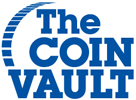The devastation left in the wake of a Nazi regime and a war torn Germany was unmeasurable. The fall of Berlin in addition to German territories being taken under control by Western Allies after the Second World War in response to the barbarity and horrors committed by Nazi Germany and their political leadership left the remainder of the country in difficult circumstances. However, life improved with years of rebuilding not only a country but an economy.
This next entry of the 100 Greatest Modern World Coins as put together by Whitman Publishing and authors Charles Morgan and Hubert Walker helped lead the country to better days. We will take a greater look at the coin leading the charge in the middle of a currency reform and that ultimately helped the German economy recover after such a tumultuous period.
#86 - West Germany 1954-G Mark
Responsible for starting the Second World War, Germany paid a price both culturally and economically as the Allied Forces rejected the idea that the cruelties committed by the Nazi regime were the responsibility of just the political leadership. The nation as a whole was at fault in the eyes of the Allied powers, which in turn, gave them control of every avenue of German life and the ability to shape the country’s identity after the war was over.
While the reshaping of the country took effect under the control of Western Allies, the German territories would eventually gain independence three years after the war and assembled the People’s Republic of Germany, or Bundesrepublik Deutschland, or West Germany. The Eastern part of Germany was still under Soviet rule but was able to form the German Democratic Republic, or Deutsche Demokratische Republik, or East Germany.
Along with the ruin and the rubble, hunger as well as the city being muddled with active explosives that had yet to go off made life for the Germans difficult amidst a complete rebuild. However, with the leadership of a favored government and a return of industry, West Germany’s economy slowly but surely began to recover. A currency reform in 1948 also helped with the recovery as half of the country’s foreign debt was forgiven by an international community. This helped the German economy move forward with investment capital that would help to build modern cities and the infrastructure needed to sustain them. In turn, this allowed for international trade to open up and German products were once again traded all over the world. The West German economy endured a drawn out economic growth period and what followed was a stability that would come to be known as the Wirtschaftswunder, or the economic miracle.
During this economic growth, the West German deutsche mark was described as the coin that helped lead them through the recovery. The small metal coin would circulate from 1950 all the way until 2002. Designed by engraver J. Bernhardt, the coin was meant to reset the iconography of the German territory in a post Nazi world. The obverse of the coin featured an eagle while “BUNDESREPUBLIK DEUTSCHLAND” is seen inscribed around it. The mint mark can be seen at the 6 o’clock portion of the coin. The reverse depicts two sprigs of oak leaves on either side of a large number 1. Underneath the 1 is the denomination “DEUTSCHE MARK” and the date featured below it.
The coin at the heart of this entry, the 1954-G, is considered a key date for the series. Considered a collectible coin, the coin in a Mint State condition is rare although it has seen a significant decline in value over the years. However, regardless of the decline, the West German mark is considered one of the most crucial German issued coins in the second half of the 20th century.
